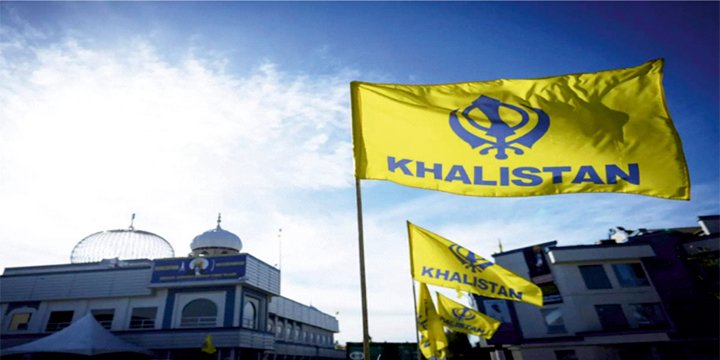KHALISTAN MOVEMENT
WHY IN NEWS ?
- Recently a row between India and Canada surrounding Sikh independence, commonly referred to as the Khalistan movement, continues to cause tensions.
MORE ABOUT THE NEWS :
- Canadian Prime Minister Justin Trudeau stood up in the Canadian Parliament in Ottawa to make a starling announcement.
- He alleged that agents of the Indian government were involved in the killing of a Canadian national, Hardeep Singh Nijjar.
- India categorically denied Mr. Trudeau’s allegations, calling them “absurd”.
- India also pointed out that not just Nijjar, many people wanted for Khalistani separatist violence in India received “safe haven” in Canada.
- India has also suspended visa services across Canada, and will not accept applications from Canadians at any other mission worldwide, the MEA said, citing security concerns.
WHAT IS KHALISTAN MOVEMENT ?
- Khalistan is the name of the proposed state envisioned by some Sikhs.
- The proposed state involves the Indian state of Punjab as well as other Punjabi-speaking areas of northern India to establish a Sikh nation.
- The ethno-religious liberation movement gained traction in the 1970s and early 80s in India.
- It later died down but has developed momentum among the Sikh diaspora in recent years.
- Some Khalistan supporters have called for the incorporation of the Pakistani side of Punjab.
- There is division among supporters of Khalistan on the boundaries of a sovereign Sikh state, but most agree that it would encompass the state of Punjab in India.
- While other groups argue that some areas of Haryana and Himachal Pradesh, states surrounding India’s Punjab, should also form part of the proposed nation.
- The historical Punjab region is located in the northern part of the Indian subcontinent and includes modern-day eastern Pakistan and northwestern India.
- In India, it includes cities like Ludhiana, Amritsar, Chandigarh and Jalandhar; and Lahore, Faisalabad, Nankana Sahib, Rawalpindi and Multan in Pakistan.
HISTORY OF KHALISTAN MOVEMENT:
- The notion of Khalistan is rooted in Sikhism, a faith that arose during the 15th century when northern India was under Mughal rule.
- Led by Guru Gobind Singh, the faith was recast in 1699 under Khalsa, a word derived from Arabic meaning pure, to incorporate a political vision to protect Sikhs and other religions from religious persecution and to establish Sikh rule.
- Following the partition of the Indian subcontinent in 1947, the Punjabi Suba movement emerged which called for the establishment of a Punjabi-speaking autonomous Sikh state.
- In 1952, the then-Indian Prime Minister Jawaharlal Nehru declared he would suppress the demand for a Punjabi-speaking state, leading to divisions between Sikhs and Hindus.
- Ultimately, in 1966, the state of Punjab was created with Chandigarh as its capital.
- In the 1970s and 80s, following for the Khalistan movement re-emerged among Sikhs in India and the diaspora.
- Spurred by the Sikh rebel leader, Jarnail Singh Bhindranwale, the movement became an armed rebellion.
- The rebellion lasted more than a decade and was suppressed by a violent crackdown by the Indian government, in which thousands of people were killed, including prominent Sikh leaders.
- In 1984, Indian forces stormed the Golden Temple, Sikhism’s holiest site, in Amritsar, Punjab to flush out separatists who had taken refuge there.
- The operation killed about 400 people, according to official Indian government figures, but Sikh groups say thousands were killed.
IMPACT OF KHALISTAN ON INDIA- CANADA RELATIONS:
- If the crisis escalates, trade and investments could take a hit.
- In 2022, India was Canada’s 10th largest trading partner.
- Goods exports to India amounted to $5.4 billion and services exports, $6.2 billion, according to the Trade Commissioner Service.
- Imports from India were $6.4 billion and $2.9 billion, respectively.
- According to Trading Economics/UN Comtrade data, Canada’s top export to India in 2022 were fossil fuels and related products (nearly $1 billion), followed by fertilisers (close to $748 million), and wood pulp and plant fibres ($384 million).
- According to Reuters, more than 600 Canadian companies and organisations have a presence in India.
- Bilateral commercial relations between the two countries are worth $100 billion, which includes $70 billion of Canadian portfolio investment in India.
- Bilateral goods trade between Canada and India rose to $8.2 billion in 2022, up 25 per cent from a year earlier.
- If Canada imposes restrictions on student visas or the Indian government creates hurdles, it will reduce student inflow.
- This will hurt Canada as well, as CBIE data show Indian students contributed $4.9 billion to the Canadian economy in 2021.
- India suspended issuing visas to Canadian citizens amid the escalation, citing “security threats” disrupting work at its missions in Canada.
- Also, in a tit-for-tat move, India expelled one of the top Canadian diplomats last week after Canada’s foreign minister expelled Pavan Kumar Rai, the most senior member of India’s foreign intelligence agency operating in Canada.
HOW DID OTHER COUNTRIES REACTED ?
- The West has been rather retrained in their reaction to the ongoing row as they see India as a counterweight to China.
- The Five Eyes — an intelligence sharing alliance of the US, UK, Australia, Canada and New Zealand — have not extended wholehearted support to Canada.
- The US is positioning itself as a possible mediator between Ottawa and Delhi.
- According to experts cited by the BBC, Canada’s interests currently pale in comparison to India’s massive strategic importance.
- It’s unlikely Canada’s allies, including the US, the UK and France, “will cut ties with India due to Trudeau’s allegations”.
WAY FORWARD:
- Each of the Five Eyes countries have issued statements expressing concern over Canada’s allegations and called on India to cooperate with the investigation.
SYLLABUS: MAINS, GS-2, INTERNATIONAL RELATIONS
SOURCE: BUSINESSLINE




